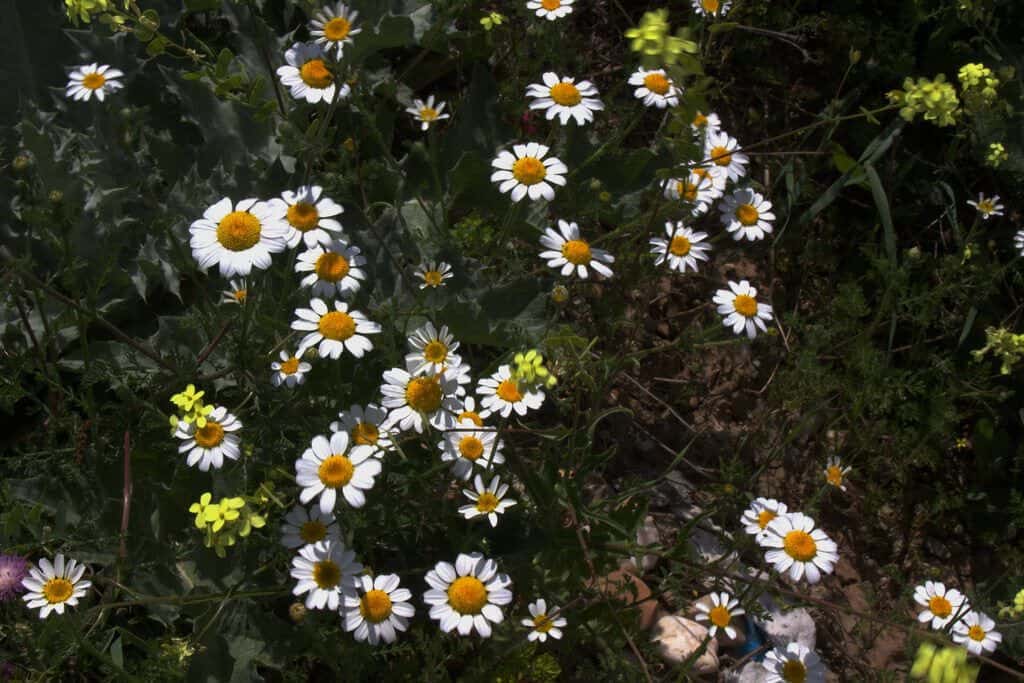Steps to Follow to Plant Chamomile: [Complete Guide]

If you like infusions, you have surely heard of chamomile. One of the most common and consumed worldwide.
Chamomile (Chamaemelum nobile) is an aromatic and medicinal herb native to Europe.
It is known and used since ancient times, especially for its healing properties.
Important Points to Plant Chamomile:
- When? In spring.

- Where? It grows in places with a temperate climate. It can grow in partial shade.
- How long does it take to germinate? Chamomile germinates approximately 14 days
- How do we prepare the land? Do not use sandy or clay soil. Try to give a good amount of nutrients through compost, earthworm humus and manure.
- How do we water? Ideal, drip irrigation. We will avoid flooding the land.
- How to sow? Here step by step.
- How do we harvest? Once the chamomile has flowered (usually every year) you can cut off the part you are going to use with scissors.
- Plagues and diseases? Thrips, aphids and mealybugs.
- Favorable associations? Other medicinal or aromatic plants, in addition to garlic.
crop association
Chamomile can be planted together with other medicinal and aromatic plants to share nutrients. You can also plant it next to any kind of chili or garlic to ward off pests such as Trips.
Where and when to sow?
 Chamomile can be planted in a medium-sized pot, that is, onedepth between 20 and 30 centimeters.
Chamomile can be planted in a medium-sized pot, that is, onedepth between 20 and 30 centimeters.
If you don’t have one of that size, you can let it grow first in a small pot and once it has germinated, transplant it.
If you are going to plant chamomile in a garden, take care that between each unit there is a25 centimeter gapto ensure that it can supply itself with all the necessary nutrients.
It grows in places with a temperate climate and hashigh sunlight requirements.For this reason, it is preferable that you sow it in the sunny season to facilitate its growth. However, they also grow in partial shade.
In cold season you can place it in a greenhouse cover it with a mesh that protects it from the cold. Give it extra light if needed.
How do we prepare the land?
 chamomilerequires many nutrientsso it is recommended that you use soil rich in them.
chamomilerequires many nutrientsso it is recommended that you use soil rich in them.
To distinguish this type of soil you have to avoid it being sandy and look for it to be blackish in color because that means that it contains nutrients. Equally,do not use very clay soilsince it will cause there to be no good drainage and the plant will rot.
In case you do not have the required type of soil, a good option is to add compost or earthworm humus. However, any other substrate would also help the plant to grow. Take care that the soil is not compacted at the time of sowing chamomile.
How do we water?
chamomileneeds the soil to stay moistbut it does not need excessive watering, so you can opt for a light watering every time you notice that the soil is dry.
Another way to water the plant is to place a container with water under the pot and let it absorb the necessary water.
Sow Chamomile Step by Step
First you have to select the correct type of soil, remove the weeds and add some type of substrate from those already mentioned above.
To directly sow the seed in the ground considerthree times the diameter of the seedand plant at that depth. Once the seed is buried, cover it with soil without crushing it.
Water daily with a spray or drip irrigation, that is, do not let the stream of water fall directly on the seed until it germinates.
When and how is chamomile harvested?
 Chamomile germinates approximately 14 daysafter planting. If you planted it in a small pot and you want to transplant it, it is recommended that you do it when the plant already has two leaves.
Chamomile germinates approximately 14 daysafter planting. If you planted it in a small pot and you want to transplant it, it is recommended that you do it when the plant already has two leaves.
Once the chamomile has flowered (usually every year) you can cut off the part you are going to use with scissors. Take care that the plant is about 5 to 10 centimeters.
Once you’ve cut it down, the chamomile will eventually sprout again. Preferably harvest on dry days so that the flowers lose moisture quickly. Once they are completely dry, store them in containers without exposing them to the sun.
To encourage the plant to produce flowers, it is necessarythat you prune it frequently,that is, cut off dry, yellow leaves, extra stems, and weeds.
Take care that your water requirements are covered. Likewise, give them compost once a month if yellow leaves predominate a lot.
What pests and diseases does it have?
 Among the most common pests and diseases in chamomile arethrips, mealybugs and aphidsespecially in spring, summer and autumn.
Among the most common pests and diseases in chamomile arethrips, mealybugs and aphidsespecially in spring, summer and autumn.
To avoid any type of these animals it is necessary that you continuously cut the weeds. Likewise, check the entire plant daily, including the soil, to prevent pests.
If you detect leaves curled at the tip with black dots, it is most likely that the chamomile has thrips. Once you have confirmed it, you can choose to wash with neutral potassium soap or make a chili garlic spray solution and spray it on the plant.
On the other hand, aphids hide on the underside of leaves. To eliminate them, it is preferable that you use natural insecticides such as potassium soap or neem oil.
Mealybugs in large numbers can become a pest so it is better to remove them from the plant as soon as you see them.
One option to eradicate them is to use diatomaceous earth of organic origin, as well as eliminate moisture in areas where you have seen mealybugs in which they disappear completely.
Another factor that usually increases the presence of pests is the modification of climatic conditions such as temperature and humidity that can accelerate the reproductive cycle of organisms.
Therefore, keep the plant conditions stable.
Benefits of this plant
- Chamomile is an aromatic herb native to Europe. It has been used mainly for its medicinal properties.
- It is characterized by being anti-inflammatory, relaxing and slightly sedative.
- As an anti-inflammatory, it helps the digestive system to eliminate gas and abdominal pain.
- As a relaxant and sedative, it also helps to relieve pain from arthritis, menstruation and stress.
- It is also used to decongest the respiratory tract and reduce both the effects of asthma and the flu.
- Chamomile is also used for conjunctival washes, that is, you can wash the eye area with chamomile water to reduce irritation which can be caused by contamination, excess exposure to dust or light infections.


![Photo of Violet Flowers: [Examples, Care, Characteristics and Meaning]](https://www.complete-gardening.com/wp-content/uploads/2022/08/violet-flowers-examples-care-characteristics-and-meaning-390x220.png)
![Photo of Spinach Irrigation: [Needs, Frequency and Procedure]](https://www.complete-gardening.com/wp-content/uploads/2021/06/espinacas_cultivo_1621208188-390x220.jpg)
